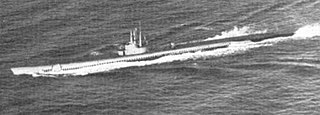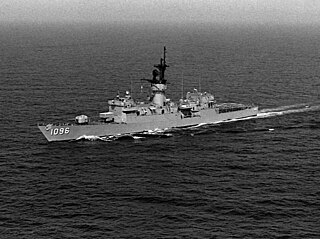
USS Runner (SS/AGSS-476), a Tench-class submarine, was the second ship of the United States Navy to be named for the runner, an amberfish inhabiting subtropical waters.

USS Barney (DD-956/DDG-6) was a Charles F. Adams-class guided missile destroyer in the United States Navy. She was the third Navy ship named for Commodore Joshua Barney USN (1759–1818).

USS Stickell (DD-888) was a Gearing-class destroyer of the United States Navy. She was named for Lieutenant John H. Stickell USNR (1914–1943), who was killed in action at Jaluit Atoll in the Marshall Islands on 13 December 1943 and posthumously awarded the Navy Cross. She was renamed HS Kanaris (D212) on transfer to the Hellenic Navy in 1972.

USS Willis A. Lee (DD-929) was a Mitscher-class destroyer in the United States Navy. She was named for Vice Admiral Willis A. "Ching" Lee USN (1888–1945).

USS Biddle (DLG-34/CG-34) was a Belknap-class guided missile frigate/cruiser of the United States Navy. She saw action in Vietnam, where she is believed to be the last ship to down an enemy aircraft with hand-loaded guns. She was involved in the Gulf of Sidra incident in 1981. The cruiser was decommissioned on 30 November 1993 and sold for scrap on 4 December 2000.

USS Damato (DD-871) was a Gearing-class destroyer of the United States Navy. She was named for Corporal Anthony P. Damato USMC (1922–1944), who was killed in action during the Battle of Eniwetok in the Marshall Islands and posthumously awarded the Medal of Honor.

USS Vogelgesang (DD-862) was a Gearing-class destroyer in the United States Navy. She was named for Rear Admiral Carl Theodore Vogelgesang USN (1869–1927).

USS Skipjack (SSN-585), the lead ship of her class of nuclear-powered attack submarine, was the third ship of the United States Navy to be named after the skipjack tuna.

USS South Carolina (CGN-37) was the second ship of the California class of nuclear-powered guided missile cruisers in the United States Navy.

USS Sea Leopard (SS-483), a Tench-class submarine, was the only ship of the United States Navy to be named for the leopard seal. Her keel was laid down by the Portsmouth Navy Yard on 7 November 1944. She was launched on 2 March 1945 sponsored by Hon. Margaret Chase Smith, United States Congresswoman from Maine, and commissioned on 11 June 1945.

USS Harry E. Yarnell (DLG/CG-17) was a Leahy-class guided missile cruiser of the United States Navy. Named in honor of Admiral Harry E. Yarnell (1875–1959), she was originally classified as a "destroyer leader" or frigate, in 1975 she was redesignated a cruiser in the Navy's ship reclassification. She was the second of the "double-end" Leahy-class guided missile frigates to join the fleet.

The USS Talbot (FFG-4) was the fourth Brooke-class frigate guided missile frigate and laid down on 4 May 1964 at Bath, Maine, by the Bath Iron Works Corp.; launched on 6 January 1966; sponsored by Miss Frances K. Talbot; and commissioned on 22 April 1967. The ship was named for U.S. Navy Captain Silas Talbot.

USS William V. Pratt (DLG-13/DDG-44) was a Farragut-class destroyer in the service of the United States Navy. She was commissioned in 1961 as DLG-13 and reclassified as a guided missile destroyer, designation DDG-44, in 1975. She was named to honor Admiral William Veazie Pratt, a President of the Naval War College and a Chief of Naval Operations.

USS Vreeland (FF-1068) was a Knox-class frigate of the United States Navy. The ship was named for Rear Admiral Charles E. Vreeland (1852–1916).

USS Aylwin (FF-1081) was a United States Navy Knox-class frigate. She was the fourth vessel named for John Cushing Aylwin. Aylwin was laid down on 13 November 1969 at Westwego, La., by the Avondale Shipyard, Inc.; launched on 29 August 1970; sponsored by Mrs. Charles K. Duncan; and commissioned on 18 September 1971 at the Boston Naval Shipyard.

USS Ainsworth (DE/FF-1090) was a Knox-class frigate named for Vice Admiral Walden L. Ainsworth (1886–1960). Ainsworth (DE-1090) was laid down at Westwego, Louisiana, on 11 June 1971 by Avondale Shipyards, Inc.; launched on 15 April 1972; sponsored by Mrs. Katharine Gardner Ainsworth, the widow of Vice Admiral Ainsworth; and commissioned on 31 March 1973 at the Norfolk Naval Shipyard, Portsmouth, Virginia.

USS Thomas C. Hart (FF-1092) was a Knox-class frigate, named for Admiral and Senator Thomas C. Hart. Thomas C. Hart (DE-1092) was laid down on 8 October 1971 at Westwego, La., by Avondale Shipyards, Inc.; launched on 12 August 1972; sponsored by Mrs. Reginald Bragonier, eldest granddaughter of Admiral Thomas C. Hart; and commissioned on 28 July 1973.

USS Valdez (FF-1096) is the forty-fifth Knox-class frigate and was built by Avondale Shipyard, Westwego, Louisiana, and originally designated as an ocean escort (DE-1096). Commissioned in the United States Navy from 1974 to 1991, she was the first U.S. Navy ship to be named for a Spanish-descended American war hero. In 1998, Valdez was leased to Taiwan and renamed Yi Yang (FF-939).

USS McCloy (FF-1038) was the second and final Bronstein-class frigate. Commissioned as a destroyer escort, McCloy was redesignated as frigate on 30 June 1975. Decommissioned on 14 December 1990, and stricken from the Navy list on 4 October 1991, McCloy was transferred to Mexico on 12 November 1993, where she was recommissioned as Nicolas Bravo. Named for Lt. Comdr. John C. McCloy, recipient of two Medals of Honor.

USS Waccamaw (AO-109) was a Cimarron-class replenishment oiler in the United States Navy. She was named after Waccamaw River. The original capacity was 146,000 barrels (23,200 m3).




















